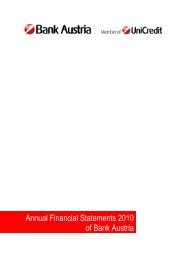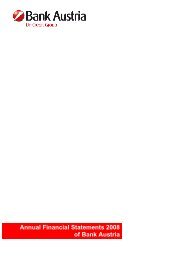Annual Financial Statements 2011 of Bank Austria
Annual Financial Statements 2011 of Bank Austria
Annual Financial Statements 2011 of Bank Austria
Create successful ePaper yourself
Turn your PDF publications into a flip-book with our unique Google optimized e-Paper software.
Consolidated <strong>Financial</strong> <strong>Statements</strong> in accordance with IFRSs<br />
E – Risk report (CoNTINuED)<br />
The chart below shows the backtesting results for the regulatory trading book, on the basis <strong>of</strong> clean hypothetical backtesting.<br />
Backtesting results for the regulatory trading book, <strong>2011</strong> (€ m)<br />
20<br />
15<br />
10<br />
5<br />
0<br />
–5<br />
–10<br />
–15<br />
–20<br />
Jan. 11 Feb. 11 March 11 April 11 May 11 June 11 July 11 Aug. 11 Sept. 11 Oct. 11 Nov. 11 Dec. 11<br />
IMOD-VaR mirrored<br />
Hyp P&L<br />
new IMOD-VaR<br />
Since April <strong>2011</strong>, the new model has been used for the purposes <strong>of</strong> calculating capital requirements. The relevant parameters are a 10-day holding<br />
period, a confidence level <strong>of</strong> 99% and a multiplier <strong>of</strong> 3.5. As at 30 December <strong>2011</strong>, the capital requirement was € 61.4 m.<br />
The following capital requirements result for the <strong>Bank</strong> <strong>Austria</strong> Group in connection with “stressed VaR” (S-VaR) and “incremental risk charge” (IRC):<br />
€ 159.4 m for S-VaR and € 88.0 m for IRC.<br />
Market risk management in CEE<br />
<strong>Bank</strong> <strong>Austria</strong> · <strong>Annual</strong> <strong>Financial</strong> <strong>Statements</strong> <strong>2011</strong><br />
20000000<br />
15000000<br />
10000000<br />
5000000<br />
0<br />
-5000000<br />
-10000000<br />
-15000000<br />
-20000000<br />
At <strong>Bank</strong> <strong>Austria</strong>, market risk management covers the activities in Vienna and the positions at the subsidiaries, especially in Central and Eastern Europe.<br />
These subsidiaries have local risk management units with a reporting line to Risk Management in UniCredit <strong>Bank</strong> <strong>Austria</strong> AG. Uniform processes,<br />
methods, rules and limit systems ensure consistent Group-wide risk management adjusted to local market conditions.<br />
The “IMOD” risk model has been implemented locally at major units (Czech Republic, Slovakia, Hungary, Croatia, Bulgaria, Russia, Turkey), and a daily<br />
risk report is made available to the other units; moreover all units also have technical access to the central market risk platform.<br />
The replacement <strong>of</strong> the previous internal model “NoRISK” by IMOD, a Group application, also requires formal approval <strong>of</strong> the system by the banking<br />
supervisory authorities in the major CEE countries. The approval process for the Czech Republic, Slovakia and Hungary will be implemented by 2013;<br />
the other relevant banking subsidiaries will undergo the approval process for the risk model from 2014 onwards.<br />
Analyses <strong>of</strong> position structure and balance sheet structure are available to all banks in the Group via “ALMRisk”, a Group-wide web tool. Liquidity<br />
monitoring is also based on this instrument.<br />
The web application “ERCONIS” records the daily business results <strong>of</strong> treasury activities in CEE. In line with a total-return approach, measurements <strong>of</strong><br />
the performance <strong>of</strong> subsidiaries include income generated by the subsidiaries and the valuation results <strong>of</strong> the banking book.<br />
To avoid risk concentrations in the market risk position, especially in tight market conditions, <strong>Bank</strong> <strong>Austria</strong> has implemented at its banking subsidiaries<br />
Value-at-Risk limits and position limits for exchange rate risk, interest rate risk and equity risk, which are monitored daily. The monitoring <strong>of</strong> income<br />
trends at banking subsidiaries by means <strong>of</strong> stop-loss limits provides an early indication <strong>of</strong> any accumulation <strong>of</strong> position losses.<br />
The timely and continuous analysis <strong>of</strong> market risk and income is the basis for integrated risk-return management <strong>of</strong> treasury units at banking<br />
subsidiaries.<br />
142
















